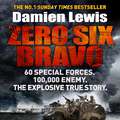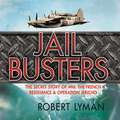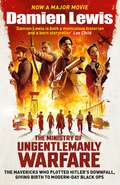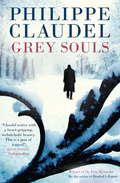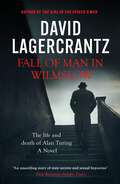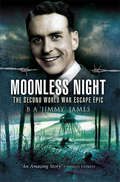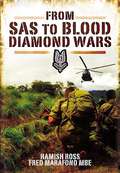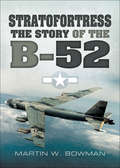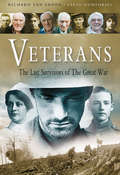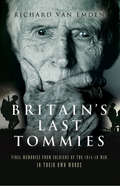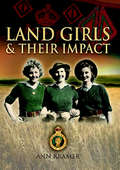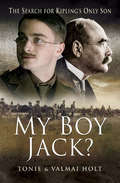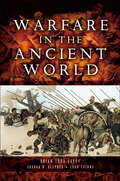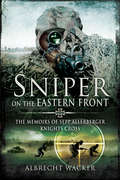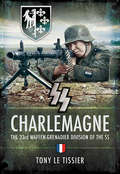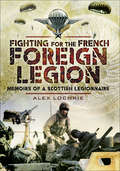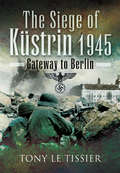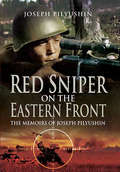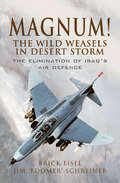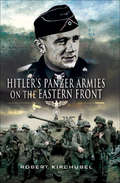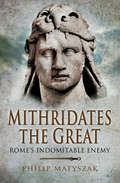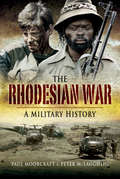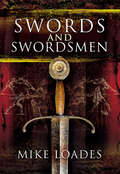- Table View
- List View
The Broken Mirrors: Sinalcol
by Elias KhouryWhy did he return to Beirut? Why did Karim leave his wife and children and the life he had built in France to return to a homeland still reeling from civil war? Was it to answer his brother Nasim's call to raise a hospital out of the ashes? Was it to kick over the traces of past love affairs? Or to establish the truth behind his father's death? Or was it to confront at last the ghost of the man known only as "Sinalcol", a legendary phantom of the civil war, and a broken mirror of himself? In Beirut, Karim will learn the fate of old comrades, and face a brother who shares a past as divided as the city itself. And he will find that peace is only ever fleeting in a war without end.
Zero Six Bravo: 60 Special Forces. 100,000 Enemy. The Explosive True Story
by Damien LewisDamien Lewis has spent twenty years reporting from conflict zones around the world. Zero Six Bravo--a Sunday Times number one bestseller--tells the story of "sixty special forces against 100,000--a feat of arms to take the breath away." (Frederick Forsythe) They were branded as cowards and accused desertion. But nothing could be further from the truth. Ten years on, the story of these sixty men can finally be told. In March 2003, M Squadron--an SBS unit with SAS embeds--was sent 1,000 kilometers behind enemy lines on a true mission impossible, to take the surrender of the 100,000-strong Iraqi Army 5th Corps, an operation so risky it earned the nickname â??Operation No Return' right out of the gate. Caught in a ferocious ambush by Saddam Hussein's Fedayeen, plus the awesome firepower of the 5th Corps' heavy armor, and with eight of their vehicles bogged in Iraqi swamps, M Squadron launched a desperate bid to escape, inflicting massive damage on their enemies. Running low on fuel and ammunition, outnumbered, and outgunned, the elite operators destroyed sensitive information and prepared for death or capture as the Iraqis closed their deadly trap. Zero Six Bravo contains previously unpublished information detailing the essential involvement of American troops in this astonishing military feat. Zero Six Bravo recounts in vivid and compelling detail the most desperate battle fought by British and allied Special Forces trapped behind enemy lines since World War Two.(P)2014 WF Howes Ltd
The Jail Busters: The Secret Story of MI6, the French Resistance and Operation Jericho
by Robert LymanIn the new year of 1944 the French Resistance in northern France was on its knees. Relentless attacks on its diverse and disorganised networks by the Gestapo and the Abwehr had put many of its best operatives in prison, or worse. But in the lead up to Operation Overlord, 'D Day', the Resistance had never been more important to the Allied war effort, and many groups were in the pay of Britain's Secret Intelligence Service, MI6. One such was organised by a patriot called Dominic Ponchardier. For months he had watched helplessly as his friends and colleagues had been swept up by the Nazi drag net, and cast into the old prison on the eastern outskirts of Amiens. In desperation he asked his MI6 handlers for help, and once London agreed it led to one of the most daring missions of the war. On the morning of 18 February 1944, nineteen Mosquito bombers flew at low level across the channel, skimming just above the ground to drop their bombs on sections of the walls of Amiens Prison. Hundreds escaped, scores of whom evaded recapture to continue the fight against Nazi repression. It was an epic of precision bombing, in which one of the most notable RAF heroes of the war, Group Captain Charles Pickard, lost his life. Robert Lyman's book reveals, from previously unseen sources, the full truth of MI6's involvement in the French Resistance, and narrates in vivid detail a stirring tale of courage and skill.(P) 2014 WF Howes Ltd
Churchill's Secret Warriors: The Explosive True Story of the Special Forces Desperadoes of WWII
by Damien LewisOne of the most remarkable stories in the history of Special Forces' operations - Daily ExpressIn the bleak moments after defeat on mainland Europe in winter 1939, Winston Churchill knew that Britain had to strike back hard. So Britain's wartime leader called for the lightning development of a completely new kind of warfare, recruiting a band of eccentric free-thinking warriors to become the first 'deniable' secret operatives to strike behind enemy lines, offering these volunteers nothing but the potential for glory and all-but-certain death. Churchill's Secret Warriors tells the story of the daring victories for this small force of 'freelance pirates', undertaking devastatingly effective missions against the Nazis, often dressed in enemy uniforms and with enemy kit, breaking all previously held rules of warfare. Master storyteller Damien Lewis brings the adventures of the secret unit to life, weaving together the stories of the soldiers' brotherhood in this compelling narrative, from the unit's earliest missions to the death of their leader just weeks before the end of the war.
Churchill's Secret Warriors: The Explosive True Story of the Special Forces Desperadoes of WWII
by Damien LewisOne of the most remarkable stories in the history of Special Forces' operations - Daily ExpressIn the bleak moments after defeat on mainland Europe in winter 1939, Winston Churchill knew that Britain had to strike back hard. So Britain's wartime leader called for the lightning development of a completely new kind of warfare, recruiting a band of eccentric free-thinking warriors to become the first 'deniable' secret operatives to strike behind enemy lines, offering these volunteers nothing but the potential for glory and all-but-certain death. Churchill's Secret Warriors tells the story of the daring victories for this small force of 'freelance pirates', undertaking devastatingly effective missions against the Nazis, often dressed in enemy uniforms and with enemy kit, breaking all previously held rules of warfare. Master storyteller Damien Lewis brings the adventures of the secret unit to life, weaving together the stories of the soldiers' brotherhood in this compelling narrative, from the unit's earliest missions to the death of their leader just weeks before the end of the war.
Grey Souls
by Philippe ClaudelA bestseller in France and winner of the Prix Renaudot, Grey Souls is a mesmerising and atmospheric tale of three mysterious deaths in an oddly isolated French village during World War I. The placid daily life of a small town near the front seems impervious to the nearby pounding of artillery fire and the parade of wounded strangers passing through its streets. But the illusion of calm is soon shattered by the deaths of three innocents - the charming new schoolmistress who captures every male heart only to kill herself; an angelic ten-year-old girl who is found strangled; and a local policeman's cherished wife, who dies alone in labour while her husband is hunting the murderer. Twenty years later, the policeman still struggles to make sense of these tragedies, a struggle that both torments and sustains him. But excavating the town's secret history will bring neither peace to him nor justice to the wicked.
Fall of Man in Wilmslow
by David LagercrantzJune 8, 1954. Alan Turing, the visionary mathematician, is found dead at his home in sleepy Wilmslow, dispatched by a poisoned apple. Taking the case, Detective Constable Leonard Corell quickly learns Turing is a convicted homosexual. Confident it's a suicide, he is nonetheless confounded by official secrecy over Turing's war record. What is more, Turing's sexuality appears to be causing alarm among the intelligence services - could he have been blackmailed by Soviet spies? Stumbling across evidence of Turing's genius, and sensing an escape from a narrow life, Corell soon becomes captivated by Turing's brilliant and revolutionary work, and begins to dig deeper. But in the paranoid, febrile atmosphere of the Cold War, loose cannons cannot be tolerated. As his innocent curiosity fast takes him far out of his depth, Corell realises he has much to learn about the dangers of forbidden knowledge.
Moonless Night: The Second World War Escape Epic
by B A James“James is the sort of person they write legends about. A participant in the mass escape that was the basis for the movie The Great Escape.” —AudioFileFrom the moment he was shot down to the final whistle, Jimmy James’ one aim as a POW of the Germans was to escape. Moonless Night describes his experiences and those of his fellow prisoners in the most gripping and thrilling manner. The author made more than twelve escape attempts including his participation in The Great Escape, where fifty of the seventy-six escapees were executed in cold blood on Hitler’s orders.On re-capture, James was sent to the infamous Sachsenhausen Concentration Camp where, undeterred, he tunneled out. That was not the end of his remarkable story.Moonless Night has strong claim to be the finest escape story of the Second World War.“An amazing story.” —The Sunday Express
From SAS to Blood Diamond Wars
by Hamish Ross Fred Marafono<p>On the point of being demobbed from the SAS, Fred Marafono was recruited by David Stirling for his private security company. After Stirling’s death, Fred found himself in the midst of Sierra Leone’s Blood Diamond wars, and formed an unbreakable bonding with the country’s champion of democracy, Chief Hinga Norman, whose leadership and tragic death are integral to the story. <p>Fred was recruited by Simon Mann for the finest of all private military companies in Africa, Executive Outcomes. Fewer than two hundred of them defeated the rebels in their strongholds. Through political weakness, Executive Outcomes were made to leave the country, and chaos ensued. Committed men like Hinga Norman and British High Commissioner Peter Penfold saw that in the absence of military commitment from the west, only high caliber mercenaries would win the fight to restore democracy: three of them kept a vital air bridge open − ‘What God abandoned, these defended’. Fred’s final action was supporting the SAS in their brilliant hostage release, ‘Operation Barras.’ <p>Peter Penfold sums it all up in the book’s foreword, writing of the, ‘confidence, trust and admiration I have for this remarkable man.’</p>
Stratofortress: The Story of the B-52
by Martin W. BowmanBoeing's mighty B-52 Stratofortress has seen continuous operational service with the United States Air Force since the type was introduced in 1957. The aircraft has been upgraded several times and has assumed many different new roles since it was originally conceived and then provided the key airborne platform for America's strategic nuclear force. It is predicted that it will serve as a front-line aircraft until 2040.Apart from the formidable threat it provided during the long years of the 'Cold War', the aircraft has played a significant part in all US overseas operations since Vietnam. The more recent include Desert Storm in 1991, the Balkan conflict, Afghanistan and the liberation of Iraq. Over 700 were built and around 80 remain in service. This book includes chapters on Concept Requirement, Design and Development, Production, Evolution and Variant Models, Operational Tasking, Operational History (with first-hand accounts from crews), Weapons and Equipment Carried, Flying the Aircraft and Current Service Operations. t will be highly illustrated with many original shots taken aboard B-52s, together with archive material and also color profiles.
Veterans: The Last Survivors of the Great War (Isis Reminiscence Ser.)
by Steve Humphries Richard van EmdenUsing the veterans own words and photographs, the book brings to life a mixture of their excitement of embarkation for France, their unbound optimism and courage, the agony of the trenches, and numbing fear of going over the top. The fight for survival, the long ordeal of those who were wounded and the ever present grief caused by appalling loss and waste of life make for compelling reading.The veterans give us first hand accounts of stark honesty, as they describe in many cases more freely than ever before about experiences which have lived with them for over 80 years.
Britain's Last Tommies: Final Memories from Soldiers of the 1914–18 War—In Their Own Words
by Richard van EmdenIn the later 2nd century BC, after a period of rapid expansion and conquest, the Roman Republic found itself in crisis. In North Africa her armies were already bogged down in a long difficult guerrilla war in a harsh environment when invasion by a coalition of Germanic tribes, the Cimbri, Teutones and Ambrones, threatened Italy and Rome itself, inflicting painful defeats on Roman forces in pitched battle Gaius Marius was the man of the hour. The first war he brought to an end through tactical brilliance, bringing the Numidian King Jugurtha back in chains. Before his ship even returned to Italy, the senate elected Marius to lead the war against the northern invaders. Reorganizing and reinvigorating the demoralized Roman legions, he led them to two remarkable victories in the space of months, crushing the Teutones and Ambrones at Aquiae Sextae and the Cimbri at Vercellae. The Roman army emerged from this period of crisis a much leaner and more professional force and the author examines the extent to which the 'Marian Reforms' were responsible for this and the extent to which they can be attributed to Marius himself.
Land Girls & Their Impact
by Ann Kramer"The impact of the land girls cannot be ignored. It was not just that women were working and farms had more women than men, women who were not part of the family or, for some of them, had even lived in the countryside before – but women were wearing trousers and filling in for men, some of whom would never return from war. For the women, their time as land girls changed their lives and how they viewed their own role in society and the family. Using original interviews and photographs from some of these land girls, historian Ann Kramer delves deeper than any previous study to understand the role of the land girls both during and after the Second World War."
My Boy Jack?: The Search for Kipling's Only Son (Wwi Ser.)
by Tonie Holt Valmai HoltA full account of the tragic life of John &“Jack&” Kipling, son of Rudyard Kipling, lost in battle during World War I. On September 27, 1915, John Kipling, the only son of Britain&’s best loved poet, disappeared during the Battle of Loos. His body lay undiscovered for 77 years. Then, in a most unusual move, the Commonwealth War Graves Commission (CWGC) re-marked the grave of an unknown Lieutenant of the Irish Guards, as that of John Kipling. There is considerable evidence that John&’s grave has been wrongly identified and for the first time in this book, the authors&’ name the soldier they believe is buried in &“John&’s grave.&” This is the first biography of John&’s short life, analyzing the devastating effect it had on his famous father&’s work.
Warfare in the Ancient World
by John Cairns Brian Todd Carey Joshua B. Allfree“An interesting study of the development of military organization and strategy across several millennia, from Bronze Age Mesopotamia to the last days of Rome.” —The Pegasus ArchiveWarfare in the Ancient World explores how civilizations and cultures made war on the battlefields of the Near East and Europe between the rise of civilization in Mesopotamia in the late fourth millennium BC and the fall of Rome.Through an exploration of twenty-six selected battles, military historian Brian Todd Carey surveys the changing tactical relationships between the four weapon systems—heavy and light infantry and heavy and light cavalry—focusing on how shock and missile combat evolved from tentative beginnings in the Bronze Age to the highly developed military organization created by the Romans.The art of warfare reached a very sophisticated level of development during this three millennia span. Commanders fully realized the tactical capabilities of shock and missile combat in large battlefield situations. Modern principles of war, like the primacy of the offensive, mass, and economy of force, were understood by pre-modern generals and applied on battlefields throughout the period.Through the use of dozens of multiphase tactical maps, this fascinating introduction to the art of war during western civilizations ancient and classical periods pulls together the primary and secondary sources and creates a powerful historical narrative. The result is a synthetic work that will be essential reading for students and armchair historians alike.“An ambitious book that sets out to cover four and a half thousand years of military history, from the rise of the first civilizations in the Near East to the fall of the Western Roman Empire.” —History of War
Sniper on the Eastern Front: The Memoirs of Sepp Allerberger, Knight's Cross
by Albrecht WackerJosef Sepp Allerberger was the second most successful sniper of the German Wehrmacht and one of the few private soldiers to be honoured with the award of the Knights Cross.An Austrian conscript, after qualifying as a machine gunner he was drafted to the southern sector of the Russian Front in July 1942. Wounded at Voroshilovsk, he experimented with a Russian sniper-rifle while convalescing and so impressed his superiors with his proficiency that he was returned to the front on his regiments only sniper specialist.In this sometimes harrowing memoir, Allerberger provides an excellent introduction to the commitment in fieldcraft, discipline and routine required of the sniper, a man apart. There was no place for chivalry on the Russian Front. Away from the film cameras, no prisoner survived long after surrendering. Russian snipers had used the illegal explosive bullet since 1941, and Hitler eventually authorised its issue in 1944. The result was a battlefield of horror.Allerberger was a cold-blooded killer, but few will find a place in their hearts for the soldiers of the Red Army against whom he fought.
SS Charlemagne: The 33rd Waffen-Grenadier Division of the SS
by Tony Le TissierIn May 1945, as the triumphant Red Army crushed the last pockets of German resistance in central Berlin, French soldiers fought back. They were the last surviving members of SS Charlemagne, the Waffen SS division made up of French volunteers. They were among the final defenders of the city and of Hitlers bunker. Their extraordinary story gives a compelling insight into the dreadful climax of the Battle for Berlin and into the conflicts of loyalty faced by the French in the Second World War. Yet, whatever their motivation, the performance of these soldiers as they confronted the Soviet onslaught was unwavering, and their fate after the German defeat was grim. Once captured, they were shot out of hand by their French compatriots or imprisoned. SS Charlemagne is a gripping, fluently written study of one of the most revealing side stories of the war.
Fighting for the French Foreign Legion: Memoirs of a Scottish Legionnaire
by Alex LochrieA soldier’s true story of danger and adventure as a modern-day legionnaire in Kuwait, Bosnia, and beyond. With no French language ability, Alex Lochrie approached recruiters for the French Foreign Legion in Paris and embarked on the demanding selection process that followed. When he was accepted, he and other prospective legionnaires were sent to Southern France to begin the harsh recruit training course. The mix of nationalities and backgrounds among his fellows was enormous. New members are traditionally allowed to change their identities—and Lochrie chose to alter his age, becoming twenty-eight instead of thirty-eight. Elite paratrooper training followed in Corsica before Lochrie earned his wings. The FFL is never far from the front line, and in this book he tells of challenging active service in former French colonies in Africa as well as during the first Gulf War, evicting Saddam Hussein from Kuwait, and operations in Bosnia and Sarajevo. This gripping account lifts the veil of mystery and myth, pulling you into the action—and revealing much about the realities of service in the Foreign Legion.
Siege of Kustrin, 1945: Gateway to Berlin (Stackpole Military History Ser.)
by Tony Le TissierThe unexpected arrival of Soviet troops at the end of January 1945 at the ancient fortress and garrison town of Kstrin came as a tremendous shock to the German High Command-the Soviets were now only 50 miles from Berlin itself. The Red Army needed the vital road and rail bridges passing through Kstrin for their forthcoming assault on the capital, but flooding and their own high command's strategic blunders resulted in a sixty-day siege by two Soviet armies which totally destroyed the town. The delay in the Soviet advance also gave the Germans time to consolidate the defenses shielding Berlin west of the Oder River. Despite Hitler's orders to fight on to the last bullet, the Kstrin garrison commander and 1,000 of the defenders managed a dramatic breakout to the German lines.The protracted siege had an appalling human cost - about 5,000 Germans were killed, 9,000 wounded and 6,000 captured, and the Russians lost 5,000 killed and 15,000 wounded. Tony Le Tissier, in this graphic and painstakingly researched account, has recorded events in extraordinary detail, using the vivid eyewitness testimony of survivors to bring the story of the siege to life.
Red Sniper on the Eastern Front: The Memoirs of Joseph Pilyushin
by Joseph PilyushinA gripping memoir of a Soviet sniper who fought against the Nazis during the siege of Leningrad and throughout World War II. Joseph Pilyushin, a top Red Army sniper in the ruthless fight against the Germans on the Eastern Front, was an exceptional soldier. His first-hand account of his wartime service gives a graphic insight into his lethal skill with a rifle and into the desperate fight put up by Soviet forces to defend Leningrad. Pilyushin, who lived in Leningrad with his family, was already 35 years-old when the war broke out and he was drafted. He started in the Red Army as a scout, but once he had demonstrated his marksmanship and steady nerve, he became a sniper. He served throughout the Leningrad siege, from the late 1941 when the Wehrmacht&’s advance was halted just short of the city to its liberation during the Soviet offensive of 1944. His descriptions of grueling front-line life, of his fellow soldiers, and of his sniping missions are balanced by his vivid recollections of the protracted suffering of Leningrad&’s imprisoned population and of the grief that was visited upon him and his family. His narrative will be fascinating reading for anyone eager to learn about the role and technique of the sniper during the Second World War. It is also a memorable eyewitness account of one man&’s experience on the Eastern Front.
Magnum! The Wild Weasels in Desert Storm: The Elimination of Iraq's Air Defence
by Brick Eisel Jim 'Boomer' SchreinerA detailed look at the day-to-day life of a pilot serving during the Persian Gulf War against Iraq. This book is based upon a journal Jim Schreiner kept during his deployment to the Persian Gulf region for Operations Desert Shield and Desert Storm. Building upon that record and the recollections of other F-4G Wild Weasel aircrew, the authors show a slice of what life and war was like during that time. The pawns in the game, the ones that actually had to do the fighting and dying were the hundreds of thousands of men and women who left their homes and families to live for seemingly endless months in the vast, trackless desert while the world stage-play unfolded. To them, the war was deeply personal. At times, the war was scary; at other times, it was funny as hell. Usually, if you survive the former, it turns into the latter.
Hitler's Panzer Armies on the Eastern Front
by Robert KirchubelAn in-depth look at the role armored formations played in the struggle between the Nazis and the Soviets. Hitler&’s panzer armies spearheaded the blitzkrieg on the Eastern Front. They played a key role in every major campaign, not simply as tactical tools but also as operational weapons that shaped strategy. Their extraordinary triumphs—and their eventual defeat—mirrors the fate of German forces in the East. And yet no previous study has concentrated on the history of these elite formations in the bitter struggle against the Soviet Union. Robert Kirchubel&’s absorbing and meticulously researched account of the operational history of the panzer armies fills this gap, using German sources including many firsthand accounts never before seen in English. And it gives a graphic insight into the organization, tactics, fighting methods, and morale of the Wehrmacht at the height of its powers and as it struggled to defend the Reich.
Mithridates the Great: Rome's Indomitable Enemy
by Philip MatyszakA military biography of Mithridates VI the Great of Pontus, Romes most persistent enemy. The Mithridiatic wars stretched over half a century and two continents, and have a fascinating cast of pirates, rebels, turncoats and poisoners (though an unfortunate lack of heroes with untarnished motives). There are pitched battles, epic sieges, double-crosses and world-class political conniving, assassinations and general treachery. Through it all, the story is built about the dominant character of Mithridates, connoisseur of poisons, arch-schemer and strategist; resilient in defeat, savage and vindictive in victory. Almost by definition, this book will break new ground, in that nothing has been written on Mithridates for the general public for almost half a century, though scholarly journals have been adding a steady trickle of new evidence, which is drawn upon here. Few enough leaders went to war with Rome and lived long to tell the tale, but in the first half of the first century BC, Mithridates did so three times. At the high point of his career his armies swept the Romans out of Asia Minor and Greece, reversing a century of Roman expansion in the region. Even once fortune had turned against him he would not submit. Upto the day he died, a fugitive drive to suicide by the treachery of his own son, he was still planning an overland invasion of Roman itself.
The Rhodesian War: A Military History (Stackpole Military History Ser.)
by Paul Moorcraft Peter McLaughlinA military history of the former British colony of Southern Rhodesia—now Zimbabwe—spanning from 1890 to the 1970s. In this exciting book, authors Paul Moorcroft and Peter McLaughlin examine the military history of Southern Rhodesia, from the first resistance to colonial rule through the period of UDI by the Smith government to the Lancaster House agreement that transferred power. They recount the Rhodesian security forces&’ operations against the Black nationalist guerillas, and the intensity of the fighting and courage of the participants will surprise and enthrall readers. Atrocities were committed by both sides, but equally the protagonists were playing for very high stakes. But this is more than just a book on military operations. The authors provide expert analysis of the historical situation and examine events up to the present day, including Mugabe&’s operations against rival tribes and white farmers. For a thorough work on its subject, this book cannot be bettered. It is essential reading for those wishing to learn more about a counter-insurgency campaign. The ingenuity of the Rhodesian military fighting against overwhelming odds and restricted by sanctions is impressive, but the outcome culminating in the Lancaster House Agreement was inevitable.Praise for The Rhodesian War&“An outstanding exception to most accounts of the Rhodesian civil war . . . achieved impressive objectivity in concentrating on operational issues.&” —Anthony Verrier, author of The Road to Zimbabwe&“The book is full of intrigue and plots. South African intelligence wanted to assassinate Mugabe, but there might also have been plans afoot to kill of Britain&’s Prince Charles during his visit to Harare.&” —Heidi Kingstone, The Star (South Africa)
Swords and Swordsmen
by Mike Loades&“A &‘must have&’ book for anyone who has an interest in edged weapons . . . Loades holds the reader&’s full attention with each sword&’s story that he tells.&” —The Lone Star Book Review This magnificent book tells the story of the evolution of swords, how they were made, how they were used, and the people that used them. It doesn&’t claim to give comprehensive coverage but instead takes certain surviving examples as landmarks on a fascinating journey through the history of swords. Each is selected because it can be linked to a specific individual, thus telling their story too and giving a human interest. So the journey starts with the sword of Tutankhamun and ends with the swords of J. E. B. Stuart and George Custer. Along the way we take in Henry V, Cromwell and Uesugi Kenshin, and there is the most detailed discussion you&’ll find anywhere of all of George Washington&’s swords. The chapters on these specific swords and swordsmen are alternated with more general chapters on the changing technical developments and fashions in swords and their use. The reader&’s guide on this historical tour is Mike Loades. Mike has been handling swords most of his life, as a fight arranger, stuntman and historical weapons expert for TV and stage. As much as his profound knowledge of the subject, it is his lifelong passion for swords that comes through on every page. His fascinating text is supported by a lavish wealth of images, many previously unpublished and taken specifically for this book.&“Superb . . . the most breathtaking coverage from the earliest days to modern times. Brilliant.&” —Books Monthly

